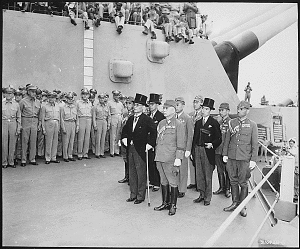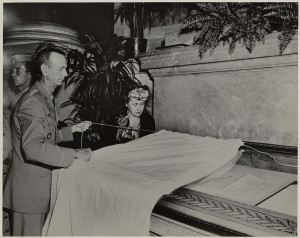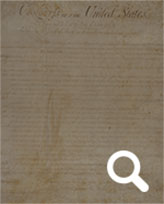Japanese Instrument of Surrender, 1945
Japanese Instrument of Surrender, 1945
 On September 2, 1945, representatives from the Japanese government and Allied forces assembled aboard the USS Missouri in Tokyo Bay to sign the Japanese Instrument of Surrender, which effectively ended World War II.
On September 2, 1945, representatives from the Japanese government and Allied forces assembled aboard the USS Missouri in Tokyo Bay to sign the Japanese Instrument of Surrender, which effectively ended World War II.
The document was prepared by the U.S. War Department and approved by President Harry S. Truman. Eight short paragraphs formalized the “unconditional surrender to the Allied Powers of the Japanese Imperial General Headquarters and of all Japanese armed forces and all armed forces under Japanese control wherever situated.” The Japanese signatories of the surrender were Foreign Minister Mamoru Shigemitsu and General Yoshijiro Umezu, Chief of the Army General Staff, and acting as Supreme Commander of the Allied Forces General Douglas MacArthur accepted their surrender. The formal ceremony was witnessed by delegates from the other Allied nations, including China, the United Kingdom, the USSR, France, Australia, Canada, the Netherlands and New Zealand.
The surrender came after almost two years of continuous defeats for the Imperial Japanese Army, compounded by the devastating atomic bombing of Hiroshima and Nagasaki in early August 1945. Word of the Japanese surrender became public on August 14, when President Truman addressed the nation, and August 15 was marked by victory celebrations across the world.
 On September 7, the Japanese Surrender Instruments were presented to President Truman in Washington, DC, and in less than a week later, they were put on public display in the Rotunda of the National Archives, where the the Declaration of Independence, the U.S. Constitution and the Bill of Rights reside today.
On September 7, the Japanese Surrender Instruments were presented to President Truman in Washington, DC, and in less than a week later, they were put on public display in the Rotunda of the National Archives, where the the Declaration of Independence, the U.S. Constitution and the Bill of Rights reside today.
Download a high-resolution version of this document from the National Archives’ online catalog.
This document was on display in the “Featured Documents” exhibit in the National Archives in Washington, DC August 27 through November 11, 2015.
The National Archives Museum’s “Featured Documents” exhibit is made possible in part by the National Archives Foundation through the generous support of The Coca-Cola Company.
Past Featured Records
-
The Emancipation Proclamation and Juneteenth
Milestones in the long struggle for American freedom
Emancipation Proclamation
President Abraham Lincoln issued the Emancipation Proclamation on January 1, 1863, as the nation approached the third year of the Civil War. Lincoln’s proclamation, which declared “that all persons held as slaves” within the rebellious states “are, and... Read more
-
Harvey Milk Writes to the President
Friday, May 31, 2024 – Monday, June 17, 2024
East Rotunda GalleryHuman Rights at the Ballot Box
In 1978, Californians voted on Proposition 6, which would have banned gay men and lesbians from teaching or otherwise being employed by California school districts. The initiative sponsored by... Read more -
Memorial Day: Honoring the Fallen
Thursday, May 16, 2024 – Wednesday, June 12, 2024
East Rotunda GalleryMemorial Day recognizes and honors the U.S. military personnel who died while serving in the Armed Forces. The first national observance of Memorial Day occurred on May 30, 1868, at Arlington National Cemetery. General John... Read more
-
The Purple Heart Battalion
Tuesday, April 16, 2024 – Wednesday, May 15, 2024
East Rotunda GalleryThe 442nd Regimental Combat Team
None of us thought we were coming home alive. —Lawson Sakai
Following Japan’s attack on Pearl Harbor in 1941, the Roosevelt administration required people of Japanese descent living on the... Read more
Frances Perkins: Champion of Workers’ Rights
Thursday, February 29, 2024 – Monday, April 15, 2024
East Rotunda Gallery“I came to Washington to work for God, FDR, and the millions of forgotten plain common workingmen.” —Frances Perkins
Chances are you benefit from the legacy of Frances Perkins,... Read more








